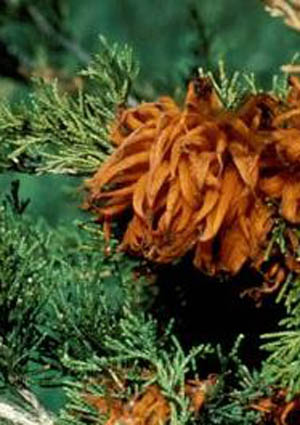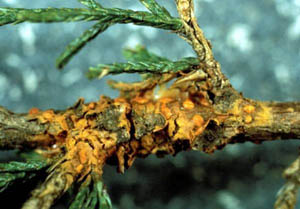Cedar–Apple and Related Rusts | |
|---|---|
| May 2, 2006 | |
|
There are three major tree rusts that occur in Illinois. We usually refer to these as the cedar–apple and related rusts, which include cedar–apple rust, cedar–quince rust, and cedar–hawthorn rust. Each requires two plant species to complete the rust life cycle. The disease is named based on the hosts on which it occurs or the hosts on which it were first reported. The alternate host of all three of these rusts is Juniperus virginiana, eastern red cedar. Damage to this juniper host is minimal. The disease begins as galls on the juniper host. The galls are still growing but lack spores for most of the fall, winter, and early spring. These galls become active in warm weather, exposing spores that then blow to other hosts, including apple, crabapple, quince, and hawthorn. Image 060305 shows swollen galls of cedar–apple rust.  Image 060306 shows the galls of cedar–quince rust, a threat to hawthorns. Look at your redcedars now to find these swollen galls.  All of the cedar–apple and related rusts can cause considerable injury to the deciduous host. Injury to apple, crabapple, quince, and hawthorn might include leaf spots, leaf discoloration, defoliation, and stem cankers with dieback. Cedar–apple rust is usually of most concern on apple and crabapple. In the past decade, landscapers and homeowners have become concerned with cedar–quince rust on hawthorn, which does not affect leaves but does cause stem galls that can kill twigs and stems. Symptoms on the deciduous hosts appear in summer. Further details can be found in the Illinois publication Report on Plant Disease, no. 802, “Rust Diseases of Apple, Crabapple, and Hawthorn,” available at http://www.ag.uiuc.edu/~vista/horticul.htm or in printed form at University of Illinois Extension offices. Management strategies are usually concentrated on the crabapple and hawthorn host. If possible, the use of a resistant cultivar is suggested. We are not aware of commercially available hawthorn species with resistance to cedar–quince rust. If feasible, galls can be removed from junipers before they swell and expose spores that will move to the alternate hosts. Fungicides can be used to control these diseases, but remember that fungicides are not a permanent fix because the chemicals provide only a preventative control measure during the year they are applied. |